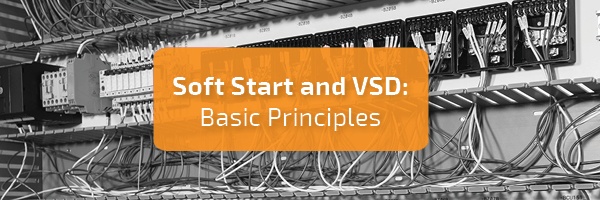Soft Start and VSD: Basic Principles
Electric motors do not just switch on and off from a dead stop to operating speed. Rather, these motors get turned on by accelerating relatively slowly until they reach their desired speed. This speed “ramping” is necessary to keep the motors from burning out due to overloading, and the most common way to achieve this ramping effect is to drive the motors with either a soft starter or variable speed drive (VSD).
Soft Starting
A soft starter modifies the applied voltage across a motor to control its acceleration and causes it to speed up (or down, in the case of a soft stop) to the desired conditions over a preset amount of time. Should the required speed and preset time cause too heavy of a load, most soft starters work with a breaker that will be tripped to avoid damage to the circuitry and the motor itself.
Soft starters are not only small, cheap, and easy to make, but another big advantage is their smooth operation. Soft starters easily control the starting current without jerking around the voltage levels, and this brings about a stable acceleration, which is necessary in precision applications.
Variable Speed Drives
Variable Speed Drives (VSDs) work on the premise of taking in a fixed sinusoidal voltage and outputting a variable one to control a motor. Having a variable version of a basic power signal gives you the ability to control the acceleration of your motors and set them to the operating speeds you need, as opposed to having one signal that jerks a motor on and off, and to only a single speed!
VSDs are made to function at continuous high level loads, and are designed to last almost indefinitely. VSDs can also be designed to take in just about any sinusoidal waveform, and thus can drive motors with very high frequencies. However, VSDs are normally very expensive and are built with very complex circuitry.
In Comparison
There are countless applications for electrical motors in today’s times, and virtually all of them require a drive in the form of a soft starter or VSD. Because of the many different purposes motors can serve, choosing the right drive can be fairly difficult.
Almost any general-case motor application will work with the cheap and easy soft starters, and if you can get away with using them, you ought to because of the time and money you’ll save.
However, there are plenty of times when you will have to drive a particularly powerful motor or a motor that will be under constant stress. Situations like these cause soft starters to fail, and require the power versatility of a VSD.
In Conclusion
So we see that soft starters are great for smaller and more general purpose applications and run way cheaper per unit price than VSDs. However, VSDs offer control of larger and more unique applications, but at a higher price tag than soft start units.
Whatever your application may be, PanelShop.com's engineers are experts in drive solutions specializing in a broad portfolio of industries and applications, and will have no problem helping you choose what type of drive would best suit your needs.
Start a conversation with us, speak to an expert today!







